January 15th, 2010
Last fall, I bought a dozen Vietnamese White Clouds in an auction at a Capital Cichlid Association’s meeting. I have never kept these fish before, but was always tempted by them in the fish stores. The one thing I never realized was how magnificent their fins can be until I put the group in my 20L and the males started displaying. In the stores, the fish just seem to hover in place, but in my tank, the males are constantly chasing each other around.

Supposedly these fish are very easy to breed, but I have not yet seen any eggs or fry in my aquarium. It’s possible that some loaches are taking care of any eggs that might be in the tank. These White Clouds seem to be fantastic fish for the planted aquarium. In addition, they can tolerate slightly cooler temperatures, so you don’t necessarily have to keep a heater in your aquarium. There is also a long-finned version of this fish which is even more impressive.
Posted in 20L Tank Log, Fish Profiles | 11 Comments »
September 13th, 2009
Back in July, I converted my quarantine tank into something of an aquascaped quarantine tank. Then, after rescaping my 75G, I had lots of extra Bolbitis, which I incorporated into this scape. This tank is really just a holding ground for plants and fish, with no CO2, minimal dosing, and a crappy light. Nevertheless, there’s no reason why it can’t look somewhat presentable.
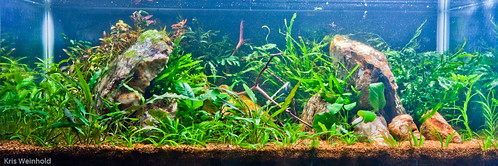
20L - 9/12/2009, click for larger
Above is what it’s looking like currently (despite the poor picture). The Sagittaria subulata is slowly creeping to the right to fill in that side, and the crypts on the left side are gradually filling that in. The Bolbitis easily filled up the space in the back right, and behind the rock on the left. Overall, it’s coming along. There’s definitely an appeal to this low-tech tank because they grow so slowly that you only need to trim a couple times a year. Comments welcome!
Posted in 20L Tank Log, Aquascaping | 3 Comments »
July 25th, 2009
Last weekend, while I was trying to get pictures of the Apistogramma baenschi “Inka” in my 20L, I also snapped a few shots of the Nerite snails and Amano shrimp while waiting for the Apistos to come out of hiding. I wanted to share a few of those shots.
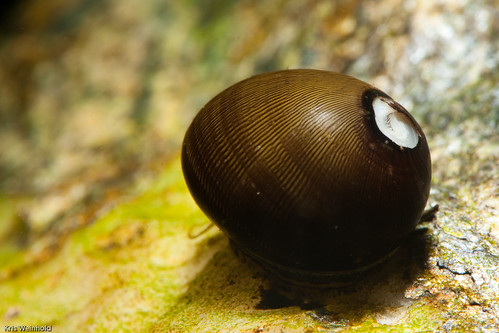
Olive Nerite Snails are by far one of the best algae eaters you can add to your aquarium, but many of them are quite pretty as well. I love the spiraling parallel lines patterned over many of their shells. I thought this guy (above) looks pretty good against the orange tones of the rock.
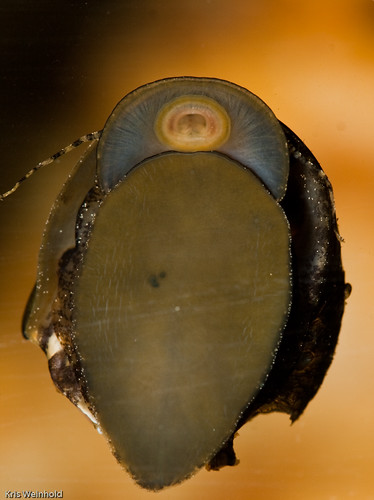
One of their key attributes is their willingness to slither along the glass, cleaning it of green spot, or other tough algae. You can see that this particular snail’s shell is slowly eroding away due to the lower pH and hardness of my water. This is fairly common in planted aquariums, especially when CO2 is injected as the carbonic acid is hard on their shells. I’ve known some hobbyists who used reef epoxy to fill in these holes, prolonging the life of their invert inhabitants.
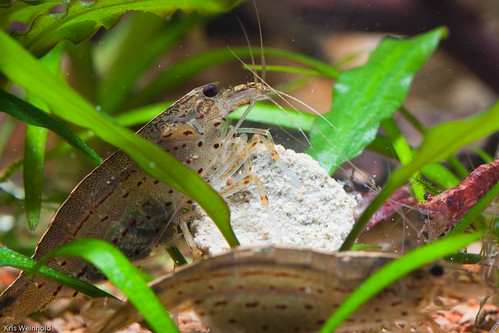
Amano shrimp are the other must have invert in nearly every aquarium. They can clear a field of hair algae in a matter of days, if added in proper proportion to the size of the tank. (That, by the way, is probably roughly 1 shrimp/2 gallons.) Too many, with too little algae, and they will start eating your moss fronds, or other delicate leaved plants. To minimize that, I feed mine algae wafers. The largest Amano in the tank usually swims right to the wafer, and holds it captive until he’s eaten his fill. Then the rest of the invertibrates in the tank swarm the leftovers. A day of the life of an invert.
Posted in 20L Tank Log, Shrimp/Snails | 2 Comments »
July 7th, 2009
I got some new rocks from a friend in GWAPA, and wanted to try them out in a tank. Unfortunately, the only free aquarium at the moment was my 20L, which was used primarily as a quarantine tank and place to hold some extra low-light plants. My friend is lucky enough to have these rocks buried in his yard. They seem to be a composite of quartz and slate, with some having very attractive orange bands through them. Overall, they have a fair amount of character up close.
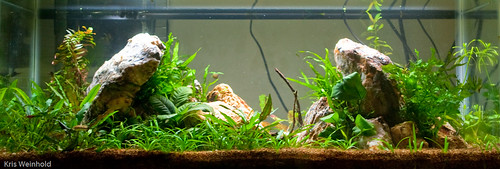
20L - Click picture for larger view
The aquascape isn’t tremendous, but I think it could have some potential if I paid much attention to it. This tank has previously been a major farm of cladophora algae, but after moving about 20 Amano Shrimp from my 40G into here, they’ve really done a tremendous job of getting it under control. If they can keep it that way, I may very well enjoy maintaining a small scape in this aquarium. I just have to make sure I can easily fish out any quarantine fish! Comments welcome.
Posted in 20L Tank Log | 5 Comments »
October 29th, 2008
The GWAPA meeting that I hosted has come and gone, and the weather outside has turned downright chilly, so it was time for me to tear down the pond for the year. I brought the Crinum americana indoors, as well, as a number of the other plants that had spent the last few months basking in the open sun. I also managed to net out about 4 dozen cherry shrimp from the bottom of the pond.
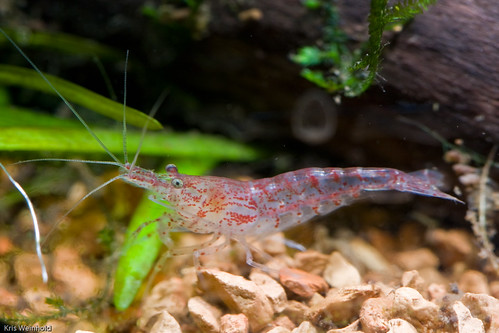
In addition to some outside maintenance, I’ve also been working to break down a few of my smaller tanks in hope that I can replace them with a larger “farm tank” to grow out a number of exotic plants that I’ve been acquiring recently. To that end, with the Jewel cichlids off to a new home, my 20H is completely empty. I piled all of the wood/rocks from that tank into my 20L quarantine tank.

This suits me just fine because I had recently put 20 juevenille bristlenosed plecos from the Catfish Convention Auction into this tank. These plecos are adoring the algae-ridden wood that was in the 20H.
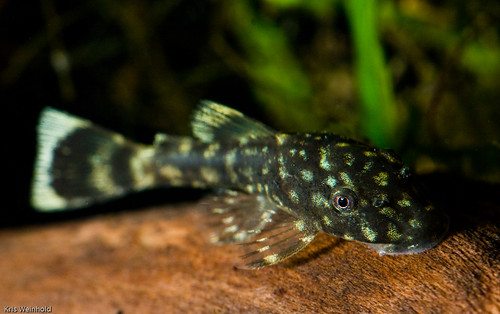
In addition to the plecos, that 20L now contains 3 I. werneri that I’ve been unable to fish out to move to my 75G, and a large number of trumpet snails that retreat to the substrate during the day, and emerge each evening.
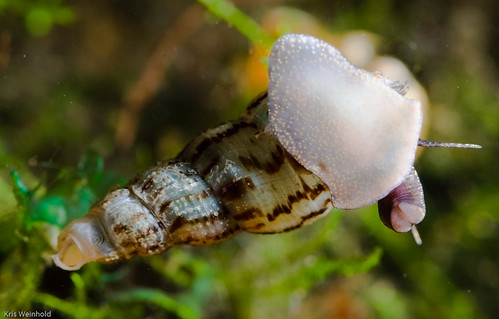
I’ve also torn down both of my 2.5G tanks that I had used for my first wormstrate/soil experiment. All that’s left is the 20L and two 10Gs, which I’ll need to consolidate at some point. I’m thinking of getting a 50 breeder, or similarly sized tank for my farm tank. Of course, we’ll see what deal comes along.
Posted in 20L Tank Log | 4 Comments »
September 8th, 2008
In a 20L aquarium, I have a small colony of Threadfin Rainbowfish, Iriatherina werneri, that I’m attempting to breed. These blue-eyes are beautiful fish that I’m hoping to eventually have a huge school for my 75G aquarium. The males are especially brilliant, displaying long fins, which they use constantly to prove their dominance to other males, and to impress females.

The males also tend to get a striking headlamp, a bright yellow/orange stripe along the top of their head, when they’re courting females. The females are not pictures here, but they do not have the elongated fins that the males do. It’s quite easy to tell them apart due to the noticable difference in finage.
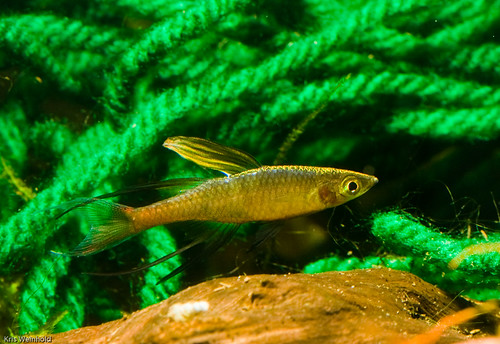
As you can see from the backgrounds in these pictures, I’ve been using spawning mops made from acrylic yarn to try and harvest eggs. The goal is to float these mops, have the fish lay eggs, and then remove the mop and place it into a hatching/rearing tank. By cycling two mops between these tank every 10-14 days, I hope to constantly have new fry. So far, I’ve been successful, but only on a very small scale.
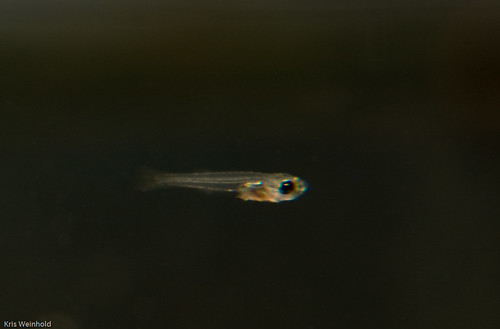
The fry are absolutely tiny when they first hatch; no more than a millimeter or two long. Right now, I have a couple that are 5-6mm long, but recently lost some to a Hydra infestation. I feed the newly hatched fry GP 5micron powder, which besides green water is just about the only thing that will fit in their tiny mouths. I’ve started feeding the larger fry some baby brine shrimp. Hopefully, they’ll grow up fast, and will be able to go in with the adults soon. If anyone’s successfully bred and raised these fish, I’d love to hear some advise.
Posted in 20L Tank Log, Fish Fry, Fish Profiles | 13 Comments »
January 29th, 2008
I’ve been growing Ranalisma rostrata in my 40G tank as the foreground for some time. When I originally setup my 20H, I decided to also plant it in there. As the 20H progressed, I realized that I had too much light, too little CO2, and too little desire to maintain the tank as I really wanted. Therefore, I removed the 55W PC light from overtop, and replaced it with an ordinary 15W fluorescent light strip. Over the past few months, besides being considerably darker than it was before, I’d noticed a huge change in the form of the Ranalisma rostrata in that tank.
Witness how the grassy plant looks in my 40G. Compact growth, overlapping each other, where each blade is thin and relatively uniform.
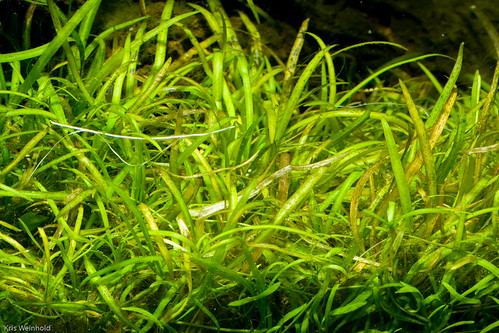
In my 20H, the growth is quite different (below), with blades more resembling a sword plant, than grass. The blades are longer and the growth is much slower. I suspect that the plant is sending out broader leaves to try and soak up more light since less is available. The color is also slightly different, with the broader leaves being a bit more pale, with a yellowish tint, where the regular form is a bright green.
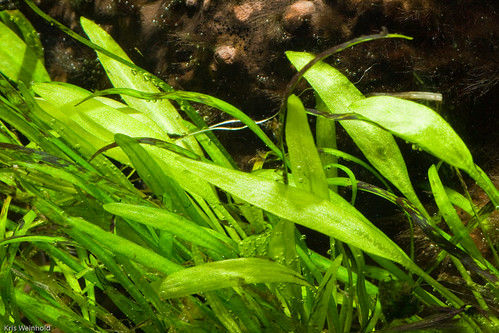
I’m sure that this same phenomenon is present in a wide variety of plants, which is why it’s difficult to say exactly how a plant will grow in another person’s tank. I’m often asked at GWAPA meetings whether a plant is high light or not. In general, I can usually only respond that I’ve only ever grown it in high light, but that they should try it out, and see if it survives in their tank. Now, I can’t even guarantee that it’ll look the same!
Posted in 20L Tank Log, 40G Tank Log, Plant Profiles | 3 Comments »
February 4th, 2007
A year or two ago, GWAPA placed a group order for a number of apistogramma. In that order, I got about 6 apistogramma borellii fish. I successfully bred these guys in a 20G high and had at couple generations going. Then, unfortunately, while I was in California at the AGA, my CO2 tank
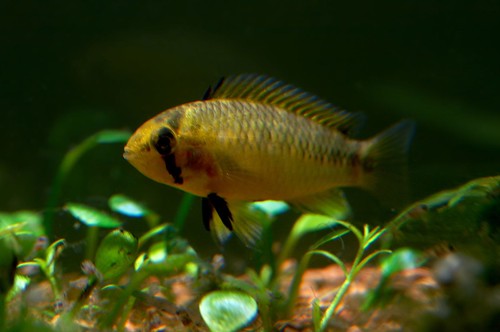
Apistogramma borellii female with babies (lower right) |
dumped the remainder of the canister into this aquarium, and killed off all of my adult fish. All of the smaller fish in the tank survived, including 5-6 borellii babies, which at the time were not sexable. I decided to dedicate a 20G long tank to try and get a new population going. After a couple months of blackworm feeding to get the fish in good breeding shape, I finally noticed the drab juevenilles coloring up — bright yellows and blues! I noticed that a pair formed, which kept 2-3 other males to the outer parts of the tank. Then, this weekend I finally see the female hovering around with a handful of babies. To get an idea of perspective, this female fish is probably only 1.5 inches long. The babies are mere millimeters. Those large looking foreground plants are marselia quadrafolia! It seems that the female has taken to guarding the fry. I haven’t seen the male near them yet.
Posted in 20L Tank Log, Fish Fry, Fish Profiles | 2 Comments »
February 2nd, 2007
I few months ago, I bought a plant from SCALES that was labeled “Rotala indica ‘Red’.” I believe this plant is probably the same thing as Rotala sp. ‘Colorata,’ but at least one GWAPA member believes this is the “real” rotala indica. Either way, this is a gorgeous stem plant that doesn’t need a ton of light to get some very vibrant red tones.

I’ve also noticed that this rotala will start to grow horizontally much more readily than many other rotala’s I’ve tried. As it does this, it sends up multiple vertical stems which can eventually be trimmed and replanted as their on stalk. The plant definitely takes off when CO2 is added, but it seems to grow, albeit much slower, without the added carbon injection. Right now I’m growing this using all SeaChem products in my 20L.
Posted in 20L Tank Log, Plant Profiles | Comments Off on Rotala indica ‘Red’
January 31st, 2007
Here is an updated picture of my 20 long tank in my office. Last week I noticed that one of the female apistogramma borellii had turned bright yellow. I haven’t seen any fry yet, but then again, I haven’t really seen the female fish either. There’s still a school of about a dozen male Endlers in here as well.
 Â
Â
The plants in this tank are rotala macrandra ‘green’, rotala indica ‘red’ (or rotala colorata), Crasula helmsii, Ranalisma rostrata, marselia quadrafolia, and Heteranthera zosterifolia. I’m finally starting to win the thread algae battle in this tank. Over the previous month or two this tank had a mess of 8″ long thread algae flowing in the current. My brother commented that at least I’m able to grow “cool looking algae,” but I wasn’t amused. Thankfully, thanks to a strict SeaChem-only dosing schedule with Excel overdoses, I’m now in control.
Maybe one of these days I’ll properly trim these stem plants. I hate growing stem plants in a 12″ tall tank! At least I like the rockwork!
Posted in 20L Tank Log | Comments Off on 20G Long – Updated Photo

















